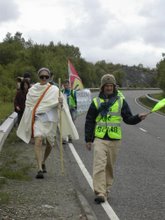The followint is a BOOK REVIEW which I wrote for the Spring issue of Fellowship Magazine.
Gandhi, A Political and Spiritual Life
Kathryn Tidrick
I.B. Tauris, 2006
By Bernie Meyer
For the authentic Gandhi, Gandhi, A Political and Spiritual Life is an important book. Kathryn Tedrick has delved into the religious and cultural sources, which motivated his creative life and his quest not only for himself, but for all humanity. Tedrick has wrestled with the core of Gandhi’s thought to uncover the forces that moved his spiritual life with its political activism.
She announces in the Preface that “the secular saint is not the Gandhi we will write about here.” His words and deeds are but an indication of his life-long yearning for moksha, pure unity with God. She makes the essential point that Gandhi saw himself as the “chosen vessel of God.” She states:
“The principal article of this belief system (Gandhi’s) has to be stated as clearly as possible at the onset. It was that he, Gandhi, was the pre-ordained and potentially divine world saviour whose coming was logically implicit in the ‘ancient’ and especially ‘Eastern’, religious writings to which so many of his English acquaintances had turned in their search for a new revelation of god’s purpose in the world.” xii
Other biographers present sources and influences which moved Gandhi, but do not dwell on the way Gandhi internalized, organized, and utilized them.
Tidrick emphasizes his consciousness. The first two chapters present her research into the influences upon him which began during his education in England when he was acquainting himself with English culture for his goal of reforming India to be like the English. The Vegetarian Society, the Theosophist Society, Esoteric Christianity and other “cutting edge” thinkers formed the framework and content of Gandhi’s thinking. In South Africa he added insights from Tolstoy, Ruskin, and Thoreau. These were influenced by Eastern thought, most notably the Gita and the Sermon on the Mount. Gandhi created his self-image in South Africa and translated them into a life of action to bring about the Kingdom of God.
Gandhi pursued “purification.” Inspired by his bible, the Gita, he sought detachment from the results, no desire, to become as dust so that god’s will would be accomplished. To these passive objectives he added the active way of Christian charity expressed in the Sermon on the Mount. Suffering became the primary means for purification. Suffering became the tool for political and social transformation. He gained insight and confidence in his political ability to influence the life of Indians and the policies and actions of his opponents. India brought struggles.
He called off the Satyagraha campaign for Independence in 1922, “walked alone” after the failure of the Round Table Conference in 1931, desperately searched for candidates who were capable of the “nonviolence of the strong” after his imprisonment during World War II. There are other Himalayan mistakes. He often took the burden upon himself because he was not pure enough for god’s purpose. Or, India was not ready for “swaraj.” Tidrick describes the lulls in his political activity with the Indian National Congress as “waiting games.”
Tidrick does not dwell on his “constructive program.” She uncovers areas, which other authors are beginning to enter, the human side of the “mahatma.” Gandhi regarded sex and eating for pleasure as “lust.” He possessed views considered as weird or bizarre, and experimented with sex which tore at his followers. Tidrick goes into detail showing how Gandhi coped with his views and activity, expending considerable space in describing “brahmacharya” (celibacy.) Gandhi had a series of relationships with women over the years. He was challenged and sometimes modified his ways, but usually clung to his truth. Tidrick does not hide her own repulsion at some of his ways.
For Tidrick Gandhi’s greatest moment was his ending the Hindu-Muslim killing in Calcutta in 1947. Truly, this was a tremendous feat. Bihar was also bloody. Gandhi negotiated an agreement to stop the killing there while ending the killing in Calcutta. His “fast to death” was his ultimate means. And, it worked not only in Calcutta but in Delhi. Tidrick does well to show the roles Gandhi’s numerous fasts played.
Gandhi considered his life an “open book.” By this he meant his “life”, not his words and writings. (xiv)
Peace makers would do well to study Gandhi’s psychological and cultural creation. His experiments led him to become what he became. His religious approach may not appeal to some. His discipline, courage, total view of human living, and ahimsa translate into a creative “culture of peace,” challenging us.
(I did not include my observation that Tidrick was repulsed by Gandhi's classic Hind Swaraj written in 1909. Gandhi held firmly to HS throughout his life. I think she did not pick up the underlying context and meaning of this "little simple book" (Gandhi) as Anthony Parel so well explicates.)








No comments:
Post a Comment